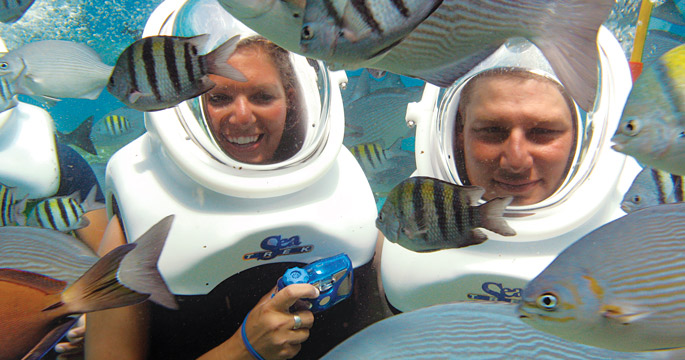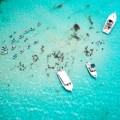Discover stunning underwater landscapes whether you stay dry, ease in or take the plunge
If you are SCUBA certified, you probably already know about Grand Cayman Island: It’s one of the top-rated dive destinations in the Caribbean, offering up stellar underwater visibility, colorful reefs, shipwrecks and plunging underwater walls. But you don’t have to be a diver to discover what lies below, and in some cases, you don’t even have to get your head wet to see under the sea. Here, from mildest to wildest, are some of the ways to discover Grand Cayman’s underwater attractions.
Under Glass
Thanks to clear waters and nearshore reefs, the west end of Grand Cayman is ideal for glass bottom boat tours. An easy and relatively inexpensive way to watch fish flit about the shallow corals or take in the remains of a shipwreck is aboard the Reef Roamer. This stable, 34-foot vessel plies the calm waters around the George Town harbor and is suitable for ages pre-K to post-retirement. It’s popular with the cruise ship crowd, so on-island visitors may want to reserve ahead rather than chance walking on.
Pseudo-Sub
If you are ready to delve a bit deeper into Grand Cayman’s underwater scene, but don’t want to lose contact with the surface, you can experience a submarine-like adventure aboard the Seaworld Observatory. This custom-built tour vessel places passengers in a below-water viewing chamber where they can easily watch the surrounding sea life, while remaining dry and in air-conditioned comfort.
Deep Perspectives
For a glimpse of what lies farther below, sign up for a tour of duty aboard the Atlantis XI. This is a true submarine, capable of moving freely about the ocean floor at depths of 100 feet. The large central passenger chamber eliminates any sense of claustrophobia, there’s no rocking motion, and because the sub is sealed and dry, there are no pressure changes during descents and assents. Individual viewing ports provide glimpses of shipwrecks, reefs and the upper edge of the island’s famous underwater walls. There are also night trips, where the sub’s powerful exterior lights are used to reveal the hidden details of reef life.
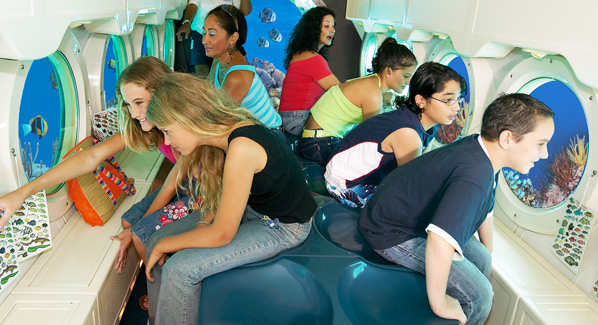
Large portholes line the sides of the Atlantis Submarine. These windows provide fantastic views and bring in light to keep passengers from feeling claustrophobic. Photo: Cayman Islands Submarine
Head in a Bubble
It’s an update on Jules Verne. Sea Trek sends you underwater with an air-filled helmet on your head and an airline providing a steady flow of fresh air from the surface. Like an old-fashioned hard hat diver, you’ll be weighted to walk on the bottom, so there are no swimming or buoyancy control skills to master. Heads stay dry during a guided underwater stroll along a marked pathway, making it possible to wear glasses or keep your contacts in place. Children as young as eight can participate.
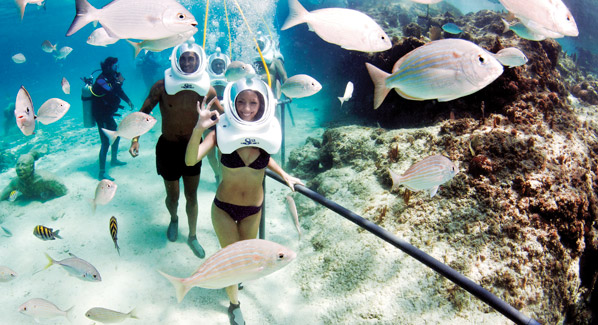
Instead of attempting to master underwater buoyancy skills, Sea Trek divers follow a handrail to enjoy a guided tour of the reefs, with no fear of bumping fragile formations. Photo: Karen Doody/SeaTREK
Lose the Tank
SNUBA is like SCUBA diving, only without the tank and other bulky equipment. The air supply remains on the surface, leaving the diver unencumbered, with just a breathing mouthpiece and a small harness that acts as a surface tether. Because depths are limited to 20 feet or less, there’s no need to consult decompression tables or deal with the other physiological concerns of deeper diving. All one needs to do is master the simple acts of breathing through a regulator and equalizing the ears during descent, then it’s off and swimming. Among the SNUBA adventures offered on Grand Cayman are fish feedings and a visit to a shallow shipwreck.
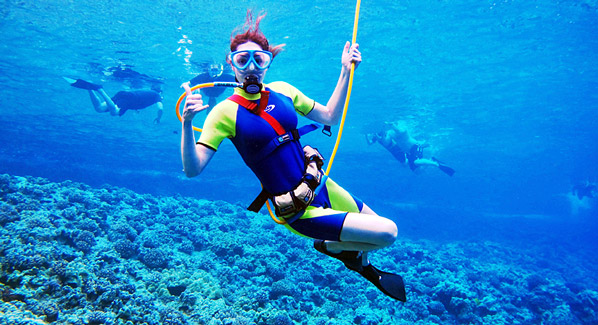
SNUBA divers get their air supply through a long hose that attaches to a tank floating on the surface. This adventure can be enjoyed with no prior dive training. Photo: Steve Foulger
SCUBA Lite
Many of the same operations that cater to active scuba divers also offer introductory programs that allow neophytes to master the basics. Programs are usually about two hours in length, and include some initial on-land instruction on the use of the equipment, followed by one or more underwater excursions. When choosing, look for programs that are sanctioned by one of the major training agencies, which include PADI, NAUI, SSI and SDI.

